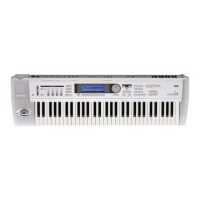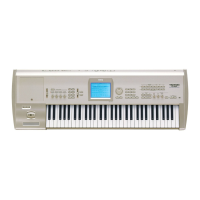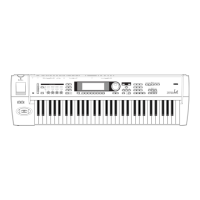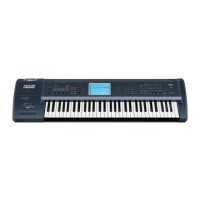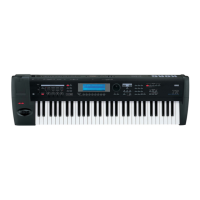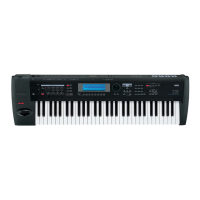10. MIDI applications
68
mitted/received. When you then change modes on the TRINITY, a Mode Change will be trans-
mitted. When you change programs or combinations, data for one program or one combination
will be transmitted together with the Program Change message. When you edit individual param-
eters, Parameter Change or Drumkit Parameter Change messages will be transmitted.
When these messages are received, the same edit will be performed as occurred on the transmit-
ting TRINITY.
When MIDI exclusive data is received and has been processed, a Data Load Completed message
will be transmitted. The controlling master device should not transmit the next data until it
receives this message (or until sufficient time has elapsed).
Data dumps of all programs or all combinations in the internal memory that you execute in Global
mode are sent directly into the internal memory of the receiving device, so there is no need to use
the Write operation. However data dumps of 1 program or 1 combination in the edit buffer, (or
parameter change edits) affect only the data in the edit buffer, and will not be stored in internal
memory unless you write the data. If you re-select the program or combination, this data will be
lost.
To write data, you can either press the [REC/WRITE] key, or use a MIDI exclusive Program Write
message or Combination Write message.
About performance editing
The Performance Editor allows you to edit main parameters while still remaining in Program Play
mode. While the Global mode P2 Enable Exclusive is checked and the unit is ready for transmis-
sion/reception of the Exclusive data, when you use the Performance Editor, exclusive parameter
change messages will be transmitted at the same time that the sound changes.
When these messages are received, performance editing will take place on the receiving device as
well. After editing, you can write the data to store it in internal memory or on a floppy disk.
These messages are transmitted and received on the Global MIDI channel.
Connecting the TRINITY to an external device for use as a
multi-timbral tone generator
The TRINITY can be connected to an external device and played as a multi-timbral tone generator
in the following ways.
● MIDI messages from the external device will play a combination. (The TRINITY will function
as an 8 timbre tone generator.) The overall settings of the TRINITY (programs, levels, effects,
etc.) can be selected by using Program Change messages to select combinations.
● MIDI messages from the external device can play a song. (The TRINITY will function as a 16
timbre tone generator.) However if the Clock Source is INT, it will not be possible to select over-
all settings.
● MIDI Clock messages from the external device can be used to control playback of the TRIN-
ITY’s sequencer (set the Clock Source of the TRINITY’s sequencer to EXT). (Refer to “Synchro-
nizing the sequencer playback.”) The overall settings of the TRINITY can be selected by using
Song Select messages to select songs.
Synchronizing the sequencer playback
In Sequencer mode, the TRINITY’s sequencer can playback in synchronization with external
devices. The Global mode Clock Source setting will determine whether the TRINITY will be the
master (the controlling device) or the slave (the controlled device).
● If the P1 MIDI Clock parameter in Global mode is set to Internal, the TRINITY will be the mas-
ter.
Playback data from the TRINITY will playback and control the internal tone generator. Tracks
for which the Track Status is EXT or BOTH will transmit their data via MIDI, so that tone gener-
ators or synthesizers connected to MIDI OUT will also play. Since exclusive data cannot be
recorded on the TRINITY’s sequencer, you will need to use a data dump if the slave device is
another TRINITY. If the slave device is a different model, use the data filter function of Disk
mode.
● If the P1 MIDI Clock parameter in Global mode is set to External, the TRINITY will be the
slave.
It will no longer be possible to control the TRINITY’s own sequencer from the front panel; it
will be controlled by the external device connected to MIDI IN. When the external sequencer is

